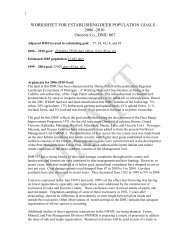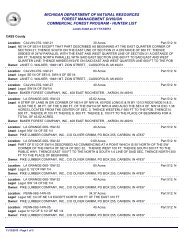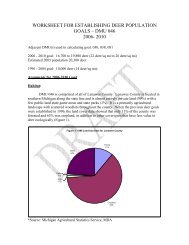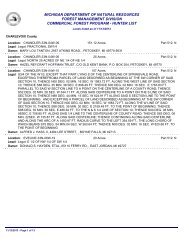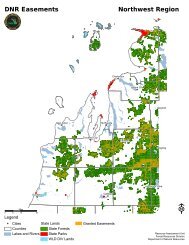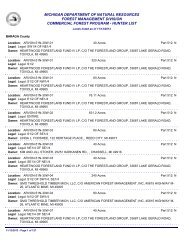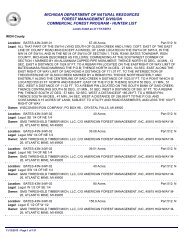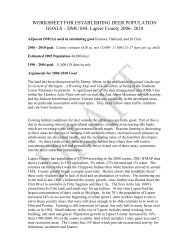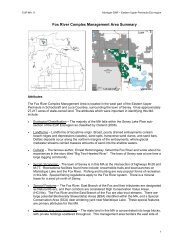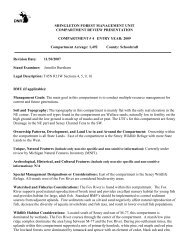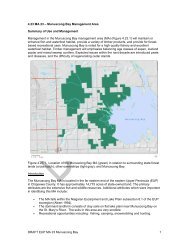DMU 040 - Michigan Department of Natural Resources
DMU 040 - Michigan Department of Natural Resources
DMU 040 - Michigan Department of Natural Resources
Create successful ePaper yourself
Turn your PDF publications into a flip-book with our unique Google optimized e-Paper software.
WORKSHEET FOR ESTABLISHING DEER POPULATION GOALS<br />
2006–2010<br />
Kalkaska Co., <strong>DMU</strong> 40<br />
Adjacent <strong>DMU</strong>(s) used in calculating goal: 5, 20, 28, and 57_<br />
2006 - 2010 goal: 11,500 to 13,500 deer ( 21 /sq mi to 24 /sq mi)<br />
Estimated 2005 population: 9,600 deer<br />
1996 - 2004 goal: 12,500 deer ( 22 /sq mi)<br />
Arguments for the 2006-2010 Goal:<br />
The deer population has declined 47% from the 2001 estimate as part <strong>of</strong> an effort<br />
to bring the statewide deer population into conformance with its goal. Declines have<br />
been recorded among the number <strong>of</strong> antlered bucks harvested (40%) and deer killed by<br />
vehicles (34%). DMAP’s used in <strong>DMU</strong> 40 have been in low demand to address deer<br />
damage in agricultural areas and has varied greatly since 2001. Snow depth and winter<br />
severity have varied among winters over the same period, but the number <strong>of</strong> deer dying<br />
<strong>of</strong> exposure has been minimal, suggesting this goal is lower than the ecological carrying<br />
capacity <strong>of</strong> <strong>DMU</strong> 40. Management <strong>of</strong> the herd at this level will minimize the impact <strong>of</strong><br />
deer browsing on forest regeneration and winter food resources in and near the<br />
extensive network <strong>of</strong> deer yards in the county. Winter mortality should be moderate in<br />
the event <strong>of</strong> a severe winter. This goal reflects a balance between the expectations <strong>of</strong><br />
hunters and wildlife viewers to see deer frequently, and the needs <strong>of</strong> the agricultural and<br />
forest management communities to raise crops without experiencing excessive deer<br />
depredation.<br />
Proposed management strategy for moving the population toward the goal:<br />
The estimated population is currently 1,900 deer below the goal, and is being<br />
allowed to increase by limiting the number <strong>of</strong> antlerless permits to 100 and their use to<br />
private lands. Landowners experiencing significant deer crop depredation are<br />
encouraged to apply for DMAP’s and permit hunter referrals to their properties. Archery<br />
hunting is popular and accounts for most <strong>of</strong> the antlerless deer harvested, but<br />
distributes hunting pressure more heavily to the less productive public land. Harvests<br />
from youth and muzzleloader seasons are minimal.<br />
Proposed management strategy for maintaining the population within the goal:<br />
Application <strong>of</strong> current deer harvest regulations to northern <strong>DMU</strong>’s with deer<br />
populations managed at or below their goals create a series <strong>of</strong> dichotomies that can be<br />
only partially addressed. The interaction <strong>of</strong> climate, landscape, and land use determine<br />
the biological carrying capacity, while the interplay <strong>of</strong> human demographics, economics,<br />
and aesthetics influence the social carrying capacity.
The more productive agricultural land will always support more deer and attract<br />
additional deer from adjacent forested lands <strong>of</strong> any ownership. However, the<br />
consolidation <strong>of</strong> several <strong>DMU</strong>’s to coincide with county boundaries in 2001 has mixed<br />
the more productive agricultural lands with the less productive public lands,<br />
necessitating a much more labor intensive approach to adjust harvest management to<br />
the biological and social demands <strong>of</strong> <strong>DMU</strong> 40. Limited availability <strong>of</strong> antlerless deer<br />
permits for private land and more liberal use <strong>of</strong> DMAP’s for landowners experiencing<br />
significant crop depredation will be used to maintain the population near goal.<br />
Goal relative to land ownership patterns, habitat, and deer distribution:<br />
<strong>DMU</strong> 40 comprises all <strong>of</strong> Kalkaska County, an inland county <strong>of</strong> 560 mi 2 , located<br />
on the western edge <strong>of</strong> a large plateau extending across much <strong>of</strong> the NLP <strong>of</strong> <strong>Michigan</strong>.<br />
Fifty-one percent <strong>of</strong> the land is publicly owned and managed as State Forest or<br />
<strong>Michigan</strong> National Guard lands. The Skegemog Lake Wildlife Area is located at the<br />
northwestern corner <strong>of</strong> Kalkaska County.<br />
Kalkaska County shows a diverse, glaciated topography, with a climate<br />
influenced by lake effect precipitation <strong>of</strong>f Lake <strong>Michigan</strong>. The resulting diversity <strong>of</strong> soil<br />
types, variable temperatures, and enhanced precipitation produce a favorable mix <strong>of</strong><br />
early successional and mast producing deciduous types interspersed with natural and<br />
plantation conifer cover. Land use is divided among agricultural, and multi-use forest<br />
production and recreation. Traverse City, the most populous area in northern <strong>Michigan</strong>,<br />
is a short distance to the west, and supplements local hunting pressure in the <strong>DMU</strong>. A<br />
few apple and cherry orchards are found in the northwest near Skegemog and Elk<br />
Lakes, and row and forage crops are raised in the central part <strong>of</strong> the County. Publicly<br />
owned land is located in the less fertile soils <strong>of</strong> the Grayling Outwash Plain covering all<br />
but the northwest corner <strong>of</strong> the County. Deer population density is greater on and near<br />
the more fertile land under private ownership.<br />
Goal relative to adjacent <strong>DMU</strong>’s within Management Unit:<br />
Deer populations in surrounding <strong>DMU</strong>’s are also below their goals. Antlerless<br />
permits are limited in number, and when <strong>of</strong>fered, are restricted to private lands. Winter<br />
severity has not been a problem the last two winters, but normally is greater in Kalkaska<br />
County than elsewhere in the NWMU.<br />
Draft<br />
Final Draft<br />
Biologist Rich Earle Rich Earle<br />
Management Unit Supervisor Penney Melchoir Penney Melchoir<br />
Field Operations Supervisor<br />
_______________<br />
Wildlife Division Chief<br />
_______________



